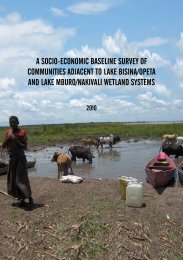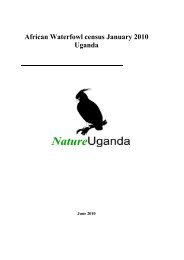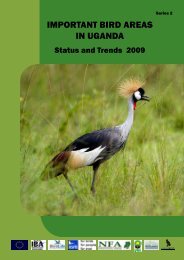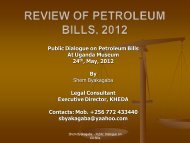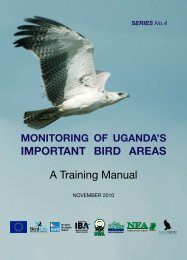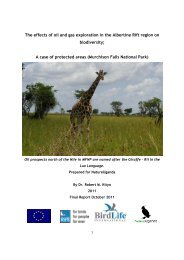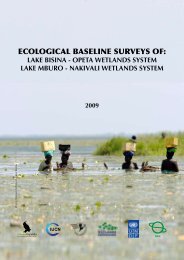the economic valuation of the proposed ... - Nature Uganda
the economic valuation of the proposed ... - Nature Uganda
the economic valuation of the proposed ... - Nature Uganda
You also want an ePaper? Increase the reach of your titles
YUMPU automatically turns print PDFs into web optimized ePapers that Google loves.
12,078 per annum by <strong>the</strong> number <strong>of</strong> households gives<br />
a total value <strong>of</strong> UShs 238,576,734 per annum. However,<br />
<strong>the</strong> impact area is 7186ha out <strong>of</strong> <strong>the</strong> total size <strong>of</strong> about<br />
30,000ha. Therefore, <strong>the</strong> value <strong>of</strong> water provision in<br />
impact area which will be lost is equivalent to UShs<br />
57,258,416 per annum. Holding this value constant over<br />
<strong>the</strong> project period, <strong>the</strong> net present value <strong>of</strong> domestic<br />
water provision translates into a conservative estimate<br />
<strong>of</strong> UShs 477,153,468 (or US $ 280,679) 8 .<br />
E. ECOTOURISM<br />
According to Pearce & Pearce (2001) ecotourism is a<br />
growing activity and contributes a potentially valuable<br />
non-extractive use <strong>of</strong> tropical forests. A review <strong>of</strong> some<br />
estimates <strong>of</strong> tourism values shows enormous variations<br />
in unit values <strong>of</strong> ecotourism. For example Maille and<br />
Mandelsohn (1991) estimated <strong>the</strong> value <strong>of</strong> tropical<br />
forest ecotourism in Madagascar at $360 – 468/ha<br />
based on a study <strong>of</strong> consumer’s surplus using <strong>the</strong> travel<br />
cost method (TCM). On <strong>the</strong> o<strong>the</strong>r hand, o<strong>the</strong>r tropical<br />
forest ecosystem values are as follows: $650/ha benefit<br />
<strong>of</strong> no logging over continued logging in a forest in <strong>the</strong><br />
Philippines (Hodgson & Dixon 1988); consumer’s surplus<br />
estimates <strong>of</strong> $ 1/ha for a site in Mexico (Adger et al 1995);<br />
$740/ha for forest recreation areas in Malaysia (Garrod<br />
&Willis 1997); and $950 – 2305/ha for two forested<br />
parks in Costa Rica (Shultz et al 1998). Generally, very<br />
8 The estimate is conservative because <strong>the</strong> population in<br />
<strong>the</strong> enclaves and <strong>the</strong> surrounding areas will increase over <strong>the</strong> years.<br />
However, it is possible with increased development, alternative water<br />
sources may be developed.<br />
Table 19: Visitor statistics<br />
Year<br />
42<br />
Foreigners/<br />
Foreign Residents<br />
high popularity sites generate much higher values as<br />
demonstrated by <strong>the</strong> Schultz et al study.<br />
Ecotourism in Mabira CFR is popular due to its proximity<br />
to large urban centres and above average biodiversity<br />
richness. The lower case value ($360/ha) for Madagascar<br />
from <strong>the</strong> study <strong>of</strong> Maille and Mandelsohn (1991)<br />
could be a reasonable average estimate. Multiplying<br />
<strong>the</strong> Madagascar value by <strong>the</strong> 7186 ha <strong>proposed</strong> for<br />
degazettement, one estimate <strong>of</strong> <strong>the</strong> ecotourism value <strong>of</strong><br />
Mabira CFR would be $2,586,960/year; and <strong>the</strong> present<br />
value at $21,558,000.<br />
On <strong>the</strong> o<strong>the</strong>r hand, according to Muramira (2000),<br />
<strong>Uganda</strong>’s tropical high forests have some <strong>of</strong> <strong>the</strong> richest<br />
biodiversity <strong>of</strong> plant and animal life in <strong>the</strong> world. However,<br />
compared to o<strong>the</strong>r national forests, <strong>the</strong> biodiversity<br />
inventory for Mabira CFR revealed that <strong>the</strong> forest has<br />
average biodiversity attributes (Davenport et al 1996).<br />
The ecotourism value <strong>of</strong> Mabira lies in <strong>the</strong> fact that it<br />
is <strong>the</strong> only THF protected area within <strong>the</strong> Lake Victoria<br />
shore crescent. Fur<strong>the</strong>rmore, Mabira CFR is close to <strong>the</strong><br />
urban centres <strong>of</strong> Kampala (53km) and Jinja (21km). There<br />
is increasing interest in ecotourism in Mabira CFR as<br />
shown in Table 20. Finally, in addition to <strong>the</strong> Ecotourism<br />
Centre operated by <strong>the</strong> NFA, new developments are<br />
ei<strong>the</strong>r nearing completion (for example <strong>the</strong> facility <strong>of</strong><br />
Ecolodges) or are in <strong>the</strong> early stages <strong>of</strong> development (for<br />
example <strong>the</strong> plans <strong>of</strong> MAFICO). These developments,<br />
amongst o<strong>the</strong>rs, point to an accelerated growth in<br />
ecotourism in Mabira CFR.<br />
Locals Total<br />
2005/06 1,989 2,854 4,843<br />
1999 1,312 2,880 4,172<br />
1998 1,450 1,125 2,575<br />
1997 1,304 1,094 2,398<br />
1996 1,097 515 1,612<br />
Source : data for 2005/06 fiscal year from <strong>the</strong> NFA<br />
: data for remaining years, Muramira (2000)<br />
The Economic Valuation <strong>of</strong> <strong>the</strong> Proposed Degazettement <strong>of</strong> Mabira CFR | 2011



